The Washington Campus
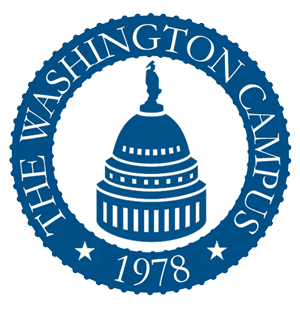 Seal of the Washington Campus Consortium | |
| Type | Public |
|---|---|
| Established | 1978 |
| Students | 1000 |
| Location | Washington, D.C. |
| Campus | Urban |
| Colors | Blue and Gray |
| Website |
www |
 | |
The Washington Campus (TWC) is a university consortium located in Washington, D.C., U.S. The Consortium was founded in 1978 by L. William Seidman, former economic advisor to President Gerald Ford, fourteenth chairman of the Federal Deposit Insurance Corporation, and first chairman of the Resolution Trust Corporation.[1]
Approximately one thousand participants take part in programs with The Washington Campus each year. The Campus provides university credit and certificate programs. Programs for academic credit are for Master of Business Administration (MBA) and Executive MBA students, as well as graduate accounting and undergraduate students. Participating students receive academic credit through their member schools. The Campus also provides certificate programs for corporate executives as well as government and embassy officials. Competition for acceptance to the degree program is competitive within consortium member schools with some members allowing fewer than 50% of applicants to participate in the program.[2]
In recent years, the number of international students attending Campus programs has increased, due in part to the growing number of partnerships in Europe and Asia.
Universities
The Washington Campus comprises leading graduate business schools:[3]
- Haas School of Business - University of California, Berkeley
- The Stephen M. Ross School of Business - The University of Michigan
- Goizueta Business School - Emory University
- Kenan-Flagler Business School - The University of North Carolina at Chapel Hill
- D'Amore-McKim School of Business - Northeastern University
- Max M. Fisher College of Business - The Ohio State University
- Kelley School of Business - Indiana University
- Krannert School of Management - Purdue University
- Mays Business School - Texas A&M University
- McCombs School of Business - The University of Texas at Austin
- The Anderson School of Management - University of New Mexico
- School of Business - Howard University
- Seidman College of Business - Grand Valley State University
- W. P. Carey School of Business - Arizona State University
- McDonough School of Business - Georgetown University
- Jones Graduate School of Business - Rice University
History
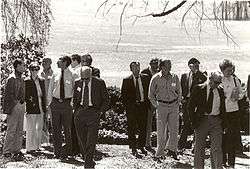
After serving in the White House as President Gerald R. Ford's Assistant for Economic Affairs from 1974 to 1977,[4] Bill Seidman, along with other notable public policy officials and academic leaders, recognized the need for current and future business leaders to better understand the organization and function of government, as well as the process of policy making, in order to more effectively contribute their experience and expertise to the decision-making process.[5] With the policy challenges confronting government officials, and the potential impact of policy decisions on the U.S. and global business climate and economy, the founders determined that it is critical for corporate leaders to engage in the process, inform the policy debate and understand the potential impact of policy changes on their own business sector.
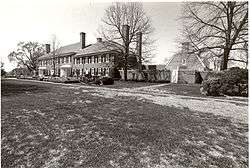
Shortly after leaving his post at the White House, Seidman, along with colleagues from the Ford administration and other leaders in Washington set about organizing the foundation for the Campus. By the fall of 1978, the Campus consortium included nine member schools: University of California, Los Angeles; University of California, Berkeley; University of Michigan; Cornell University; Dartmouth College; The Ohio State University; Grand Valley State University; the University of New Mexico; and Indiana University. The first Board of Directors meeting was held in 1979 at The Wye Plantation in Queenstown, Maryland. Since that time, the Campus has grown in size, membership and scope, and continues to add new universities to its consortium membership.
The original signers of the Articles of Incorporation are: L. William Seidman, Hugh Scott, William F. Gorog, Sidney L. Jones, James T. Lynn, Harlan Cleveland, Roger B. Porter, and John J. Bell.
In 2012, The Washington Campus moved into their current location, at the L. William and Sally Seidman Center. Although many sessions throughout each residency program are conducted in offices on Capitol Hill, and in departments and agencies such as the Federal Reserve or the Treasury Department, the center serves as the primary location for students when they are in Washington.
Administration and organization
Mission
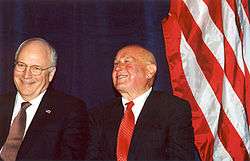
The mission of the Washington Campus, as set forth by the founders, is to establish an understanding of the public policy process in present and future business leaders. In speaking about the Washington Campus program in 2003 at the 25th anniversary dinner for the consortium, Vice President Dick Cheney underscored the importance and value of the Campus, stating that "it exposed future business leaders to the work of government. And that exposure, we think, is absolutely vital. I think oftentimes when business executives and government officials meet, they often end up talking past each other. Neither understands the other very well, sometimes. Many business executives don't begin to understand the constraints and pressures that policymakers face when they have to make a decision or evaluate a proposal. And for their part, many government officials have never met a payroll, have never run a business, have never had to deal with government regulations on the receiving end. They have no concept of what the world of business is really like, and not all of them understand the importance of free markets, low taxes, and creating an environment in which businesses and entrepreneurs can take risk and invest in new technologies, and hire more people. That's why the Washington Campus program has been so important. They're helping bridge that gap between the world of business and the world of politics. Business leaders learn to see the world as Washington policymakers see it, and policymakers often gain a better understanding of the realities of business life.”[6]
Governing bodies
The Campus is governed by a Board of Directors composed of representatives from the consortium member schools as well as business and government leaders in Washington. The president and CEO is the day-to-day administrator of the Campus and is appointed by the Board of Directors. Board members representing consortium member schools are nominated by their respective schools and largely serve as Deans or in other leadership positions at their universities. All member schools are allowed representation on the Board. At-Large Members are nominated and approved by the Board.
Academics
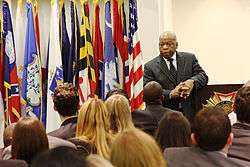
The Washington Campus' MBA courses are intensive, five-day programs held in Washington, D.C., that provides participants with first-hand exposure to the decision-making processes in federal government and an understanding of how they impact business.[7] Class discussion is generally led by a key faculty member, joined by guest lecturers from government, politics, business, and the media. All lecturers are guest speakers drawn from the highest ranks of government (such as members of Congress and current and former Executive Branch officials), the media, business and academia.[8] Students often have the opportunity to speak directly with a key editor of The Washington Post, a special advisor to the White House, or a representative of the World Bank; or they may sit in on a lecture of a professor from the John F. Kennedy School of Government at Harvard University.[9] Students from member schools receive graduate credit for participating in the programs.[10]
The programs are guided by the academic standards set forth by the graduate business schools represented on their Board of Directors. Educational programs bring participants face-to-face with experienced policymakers, senior policy advisors, and experts in public relations and advocacy who explain how Washington works, how decisions get made, and who controls each step of the process.
Program sessions are taught in the Washington Campus conference center, as well as in off-site locations such as: Congressional Committee conference rooms on Capitol Hill, Representative and Senators' offices, the US Capitol, House and Senate galleries, the Federal Reserve, the US Treasury, the US Chamber of Commerce, the Supreme Court of the United States, embassies and many other agencies and departments. Program sessions taught off-site relate to the speakers for each program and programs vary accordingly. The academic model for the Washington Campus is to use the city of Washington D.C. as the “campus” and leaders in Washington as the faculty.
The Campus maintains a network of experts across all areas of the government, who lecture on subjects including:
Government leadership
Public relations
Finance
- US Budget;[16]
- US Economy;
- US Debt and the Deficit;[16]
- Banking;[17][18]
- Securities;[19]
- Tax Code;[20]
- Regulatory Oversight;[21]
- The Regulatory Process;[22]
Business and international policy
- Corporate Business;[23]
- Corporate Responsibility;[24]
- Trade Policy;[25][26]
- The Regulatory Process;[22]
- International Policy;[27][28]
- EU Relations;[29]
- The European Union;[30]
- US-China Relations;[31]
Medical policy
Technology policy
Energy and environmental policy
Education policy
- Education Policy;[39]
Defense policy
- Defense and Homeland Security.[40][41]
- National Security and Central Intelligence[42]
- Foreign Military Policy[28]
Student activities
The Washington Campus holds sessions at many historical locations throughout each program. Typically, MBA students will have program sessions on Capitol Hill, attend congressional hearings, visit one of the agencies such as the U.S. Treasury or the Federal Reserve, and attend a luncheon/panel discussion at the National Press Club or the Capitol Hill Club. Corporate and EMBA programs are often customized for clients and sessions and locations vary accordingly. Program sessions on Capitol Hill often begin with a congressional staffer discussing the roll of staff in working for a senator, a member of congress or a congressional committee. These sessions are usually held in a Committee Hearing Room in either the House or the Senate.[43] Following discussion by congressional staff, a sitting Congressman or Senator will discuss the life of an elected official and will discuss pressing issues that they are currently facing. For many participants, these discussions help bridge the gap between the world of business and the world of politics.[6] Participants are also provided the opportunity to sit-in on Congressional Hearings.
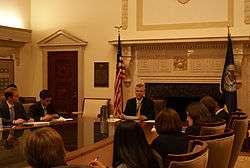
Witnessing a live hearing provides participants a first-hand perspective of the process by which legislation is created and shaped. While visiting the U.S. Treasury, program sessions include a tour of the Treasury Building as well as instruction by a senior official. Similarly, while visiting the Federal Reserve, participants receive a short tour of the Federal Reserve Eccles building before sitting down to listen to a program session taught by a senior Fed official.[43] Program sessions at social clubs such as the National Press Club or the Capitol Hill Club include a reception or a luncheon where participants eat dinner while listening to a panel discussion by Campus speakers.
Part of the learning experience in The Washington Campus program is spending time in Washington. To make the most of this experience, the Campus encourages participants to explore the city of Washington in their free time and facilitates tours and other visits on request. Many participants choose to extend their stay in Washington to take full advantage of all the city has to offer. A favorite pastime of people visiting Washington is touring the many monuments to America's founding fathers. Many of the more recognizable monuments, including the Washington Monument and the Lincoln Monument are situated along the National Mall. The White House is also adjacent to the National Mall and tours of the White House can be arranged through Congressional offices or with the help of The Washington Campus staff.

The National Mall is a large, open park area in the center of the city. Located in the center of the Mall are the Washington Monument and the Jefferson Pier. Also located on the mall are the Lincoln Memorial, the National World War II Memorial at the east end of the Reflecting Pool, the Korean War Veterans Memorial, and the Vietnam Veterans Memorial.[44] The Washington Campus often organizes monument tours as an optional activity for corporate clients. These tours typically take participants along the National Mall to see the White House, the Washington Monument and the Lincoln Memorial.[45] In the spring and summer months, many hill staffers form softball teams and play games on the Mall. The National Archives houses thousands of documents important to American history including the Declaration of Independence, the United States Constitution, and the Bill of Rights.[46]
Located directly south of the mall, the Tidal Basin features rows of Japanese cherry blossom trees that were presented as gifts from the nation of Japan. The Franklin Delano Roosevelt Memorial, George Mason Memorial, Jefferson Memorial, and the District of Columbia War Memorial are located around the Tidal Basin.[47] Many Washingtonians run or bike along the Potomac River, the Tidal Basin, or the C&O Canal.

Also located along the Mall is the Smithsonian Institution, an educational foundation chartered by Congress in 1846 that maintains most of the nation's official museums and galleries in Washington, D.C. The U.S. government partially funds the Smithsonian, thus making its collections open to the public free of charge.[48] The most visited of the Smithsonian museums in 2009 was the National Museum of Natural History located on the National Mall.[49] Some of the other Smithsonian Institution museums and galleries located on the mall are: the National Air and Space Museum and Smithsonian Institution Building (also known as "The Castle"), which serves as the institution's headquarters.[50]
The National Gallery of Art is located on the National Mall near the Capitol, but is not a part of the Smithsonian Institution. It is instead wholly owned by the U.S. government; thus admission to the gallery is free. The gallery's West Building features the nation's collection of American and European art through the 19th century.[51] The East Building, designed by architect I. M. Pei, features works of modern art.[52]
There are many private art museums in the District of Columbia, which house major collections and exhibits open to the public such as: the National Museum of Women in the Arts; the Corcoran Gallery of Art, the largest private museum in Washington; and The Phillips Collection in Dupont Circle, the first museum of modern art in the United States.[53] Some of the many other private museums in Washington D.C. include the Newseum, the International Spy Museum, the National Geographic Society Museum, and the Marian Koshland Science Museum.
Places of interest
Capitol Hill, aside from being a metonym for the United States Congress, is the largest historic residential neighborhood in Washington D.C.,[54] stretching easterly in front of the United States Capitol along wide avenues. It is one of the oldest residential communities in Washington, and with roughly 35,000 people in just under two square miles, it is also one of the most densely populated.
The Capitol Hill neighborhood today straddles two quadrants of the city, Southeast and Northeast, and a large portion is now designated as the Capitol Hill historic district. The name Capitol Hill is often used to refer to both the historic district and to the larger neighborhood around it. To the west are the National Mall and the city's central business district. Many of the congressional staffers that Campus participants meet during their trips to the Capitol live on Capitol Hill.[55]

Dupont Circle is located in the "Old City" of Washington, D.C. — the area planned by architect Pierre Charles L'Enfant — but remained largely undeveloped until after the American Civil War, when there was a large influx of new residents. The area that now constitutes Dupont Circle was once home to a brickyard and slaughterhouse.[56][57] The Washington Campus conference center is located slightly south of Dupont Circle.[58] Just farther south of the Campus is K street, an area of Washington known for its strong concentration of lobbying firms.[59]
Foggy Bottom is one of the oldest late 18th and 19th-century neighborhoods in Washington, D.C. The area is thought to have received the name because its riverside location made it susceptible to concentrations of fog and industrial smoke, an atmospheric trait that did not prevent the neighborhood from becoming the original location of the United States Naval Observatory. Foggy Bottom is west of downtown Washington, in the Northwest quadrant, bounded roughly by 17th Street to the east, Rock Creek Parkway to the west, Constitution Avenue to the south, and Pennsylvania Avenue to the north. Much of Foggy Bottom is occupied by the main campus of the George Washington University. Many of The Washington Campus speakers also serve as adjunct faculty at George Washington University as well as Georgetown University.[60]

Georgetown is a neighborhood located in the Northwest quadrant of Washington, D.C., along the Potomac River waterfront. Founded in 1751, the city of Georgetown substantially predated the establishment of the city of Washington and the District of Columbia. Georgetown retained its separate municipal status until 1871, when it was assimilated into the city of Washington. Today, the primary commercial corridors of Georgetown are M Street and Wisconsin Avenue, which contain high-end shops, bars, and restaurants. Georgetown is home to the main campus of Georgetown University, one of the Consortium members of The Washington Campus, as well as numerous landmarks, such as the Old Stone House, the oldest standing building in Washington. The embassies of France, Mongolia, Sweden, Thailand, Venezuela, and Ukraine are located in Georgetown. For much of the early history of The Washington Campus, program sessions were held in the Georgetown mansion owned by Bill and Sally Seidman.
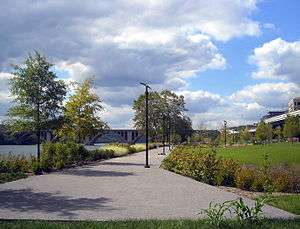
The Georgetown Waterfront Park is a new national park that is under construction in Washington, D.C. Part of the Georgetown Historic District, the park stretches along the banks of the Potomac River from 31st Street, NW to the Key Bridge. The result of many years of advocacy and fund raising, the site will feature several notable design features. Once completed, the site will link 225 miles (362 km) of parkland along the Potomac River stretching from Cumberland, Maryland to Mount Vernon, Virginia. The park was designed to passively complement the natural curve of the river. The first part of the park opened in 2008. After some delay due to construction problems, the final phase of the park has been fully funded and is scheduled for completion in 2011.

Embassy Row is the informal name for the area in Washington in which embassies or other diplomatic installations are concentrated. When international schools participate in The Washington Campus program, the Campus will often arrange for academic sessions to be held in the respective embassy of the visiting students to provide an opportunity for the students to meet their ambassador. Many ambassadors also reside on Embassy Row, which lies along Massachusetts Avenue, N.W., and its cross streets between Thomas Circle and Ward Circle, although the vast majority of embassies are found between Scott Circle and Wisconsin Avenue. Considered Washington's premier residential address in the late 19th and early 20th centuries, Massachusetts Avenue became known for its numerous mansions housing the city's social and political elites. The segment between Scott Circle and Sheridan Circle gained the nickname "Millionaires' Row".
The first embassy on Embassy Row, and still one of the most prominent, was the British Embassy, directly adjacent to the United States Naval Observatory. It was designed by Sir Edwin Lutyens to combine the offices and the residence of the ambassador, resembling an English country house in the Queen Anne style of architecture.
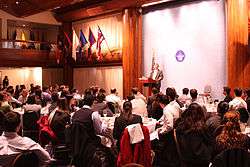
The Washington Campus periodically holds programs specifically tailored to these embassies. The embassy focused international program at the Campus helps new embassy staff members arriving in the United States to adapt to the culture of operations in Washington. These programs focus on the promotion of international understanding, provide a forum for cultural exchanges between embassy staff from different countries, and provide a focused curriculum on the practical realities of conducting diplomatic operations in Washington.[61] Many of the embassies on embassy row were converted mansions. After WWII, many nations competed to build or maintain grand residences to represent their nation's significance in the United States, and the expansive old estates proved well-suited for use as embassies (and also as lodges of social clubs).
Washington D.C. is home to many well-known organizations. The Washington Campus often takes participants to receptions and events at these sites, including the National Press Club, the Cosmos Club, and the Capitol Hill Club. The National Press Club was founded in 1908, and is one of the world's leading professional organizations for journalists. Its membership consists of journalists, former journalists, government information officers, and notable news sources. It is well known for its gatherings with invited speakers from public life. The Cosmos Club was founded in 1878 by distinguished leaders in science, literature and the arts, and counts among its members three past Presidents, two Vice Presidents, a dozen Supreme Court justices, 32 Nobel Prize winners, 56 Pulitzer Prize winners and 45 recipients of the Presidential Medal of Freedom. The Capitol Hill Club stands a short distance from the U.S. Capitol, and serves as a refined and elegant environment for business, political, and social activities. Founded in 1951, the Capitol Hill Club has served the interests of its founding party for over 60 years.
Faculty, notable speakers and alumni
- William R. Archer, Jr. Former U.S. House Representative (R-TX), Former Chairman, House Committee on Ways and Means
- Melissa Bean U.S. House Representative (D-IL)
- Ben Bernanke Chairman of the U.S. Federal Reserve
- Kevin Brady U.S. House Representative (R-TX)
- Ms. Donna Brazile Chairwoman of the Democratic National Committee
- John Breaux Former U.S. Senator (R-LA)
- Sherrod Brown United States Senator (D-OH)
- Nora Mead Brownell Co-Founder, ESPY Energy Solutions, Former FERC Commissioner
- Sharon Brown-Hruska Former Chairman, Commodity Futures Trading Commission (CFTC)
- Bay Buchanan Former Treasurer of the United States
- Richard Burr United States Senator (R-NC)
- Mr. Thomas Carr Founding Director of the White House Fellows program
- Saxby Chambliss United States Senator (R-GA)
- Vice President Richard Bruce "Dick" Cheney, 46th Vice President of the United States
- Emanuel Cleaver II U.S. House Representative (D-MO)
- Max Cleland Secretary, American Battle Monuments Commission, Former U.S. Senator (D-Georgia)
- Larry Combest Former U.S. House Representative (R-TX), Former Chairman of House Intelligence Committee, Former Chairman of House Agriculture Committee
- Bob Dole United States Senator (R-KS)
- David Dreier U.S. House Representative (R-CA)
- Chet Edwards Former U.S. House Representative (D-TX)
- Marvin H. “Mickey” Edwards Director, Rodel Public Leadership Program, Aspen Institute, Former U.S. House Representative (R-OK)
- Stuart E. Eizenstat Former Deputy Secretary of the Treasury, Former Under Secretary of State
- Bob Etheridge U.S. House Representative (D-NC)
- Jeff Flake U.S. House Representative (R-AZ)
- Mr. Malcolm Stevenson "Steve" Forbes Jr. Editor in Chief of Forbes magazine
- Barney Frank U.S. House Representative (D-MA)
- Gregory Garcia Assistant Secretary for Cyber Security and Communications, U.S. Department of Homeland Security
- David Gergen Director for the Center for Public Leadership, Kennedy School of Government, Harvard University
- Lyle Gramley Former Member of the Board of Governors of the U.S. Federal Reserve
- Ambassador Marc Ginsberg Senior Vice President, APCO Worldwide, Former U.S. Ambassador to Morocco
- Cynthia Glassman Undersecretary of Economic Affairs, U.S. Department of Commerce, Former Commissioner, U.S. Securities and Exchange Commission (SEC)
- Louie Gohmert U.S. House Representative (R-TX)
- Bill Gradison Board Member, PCAOB, Former U.S. House Representative (R-OH)
- Sam Graves U.S. House Representative (R-MO)
- Alan Greenspan Former Chairman of the U.S. Federal Reserve
- Martin Gruenberg Vice-Chairman, Federal Deposit Insurance Corporation (FDIC)
- Keith Hall Commissioner, Bureau of Labor Statistics, U.S. Department of Labor
- Mr. Steven B. Harris Board member of the PCAOB
- Martin Heinrich U.S. House Representative (D-NM)
- Robert Hunter Senior Advisor, The RAND Corporation, Former Ambassador to NATO, Former Director, Middle East Affairs, U.S. National Security
- William M. Isaac Chairman, LECG Global Financial Services, Former Chairman, Federal Deposit Insurance Corporation (FDIC)
- Johnny Isakson United States Senator (R-GA)
- Diane Auer Jones Former Assistant Secretary for Postsecondary Education
- Sidney L. Jones Former Assistant Secretary of the Treasury for Economic Policy, U.S. Department of Treasury
- John Kerry United States Senator (D-MA) Chairman, Senate Foreign Relations Committee
- Jon Kyl United States Senator (R-AZ)
- Barbara Lee U.S. House Representative (D-CA)
- Carl Levin United States Senator (D-MI)
- John Lewis U.S. House Representative (D-GA)
- Eugene Ludwig Managing Partner, Promontory Interfinancial Network, Former Comptroller of the Currency
- Stephen F. Lynch U.S. House Representative (D-MA)
- John McCain United States Senator (R-AZ)
- James P. McGovern U.S. House Representative (D-MA)
- Harry Mitchell U.S. House Representative (R-AZ)
- Vice President Walter Mondale 42nd Vice President of the United States
- Patrick Mulloy Commissioner, U.S.-China Economic and Security Review Commission
- Brad Miller U.S. House Representative (D-NC)
- Eleanor Holmes Norton United States Representative (D-DC)
- Norman J. Ornstein Resident Scholar at the American Enterprise Institute
- Ed Pastor U.S. House Representative (R-AZ)
- Mr. Ramesh Ponnuru Senior Editor for the National Review
- Roger B. Porter Former Assistant to the President for Economic and Domestic Policy
- Jack Reed United States Senator (D-RI)
- Donald W. Riegle, Jr. Former United States Senator (D-MI)
- Alice Rivlin Former Vice Chairman of the Federal Reserve
- Mr. Steven V. Roberts Former White House and Congressional Correspondent, New York Times
- Timothy J. Roemer U.S. Ambassador to India, Former U.S. House Representative (D-IN)
- Steven R. Rothman U.S. House Representative (D-NJ)
- Donald Henry Rumsfeld Former U.S. Secretary of Defense
- L. William Seidman Founder of the Washington Campus, Former Chairman, Federal Deposit Insurance Corporation
- Christopher Shays Former U.S. House Representative (R-CT)
- Debbie Stabenow United States Senator (D-Michigan), Chair of Senate Committee on Agriculture
- Charlie Stenholm Former U.S. House Representative (D-TX)
- Branko Terzic Executive Director, Deloitte Center for Energy Solutions, Former Commissioner of the Federal Energy Regulatory Commission (FERC)
- Jim Turner Former U.S. House Representative (D-TX)
- David Walker Former United States Comptroller General
- Diane E. Watson Former U.S. House Representative (D-CA), Former Chair of Congressional Entertainment Industries Caucus
- Heather A. Wilson U.S. House Representative (R-NM)
References
- ↑ "Bill Seidman". CNBC.
- ↑ "Admissions". Business School Admissions Formula.
- ↑ "MBA Programs". The Washington Campus. Retrieved 3 October 2010.
- ↑ "Ford White House". CNBC.
- ↑ "TWC History". Brussels Academy.
- 1 2 "Dick Cheney". The White House Archives.
- ↑ "TWC Programs". University of Michigan.
- ↑ "TWC Instructors". The University of Texas.
- ↑ "TWC instructors". The Ohio State University.
- ↑ "Academic credit". Texas A&M University.
- ↑ "Anderson School of Management" (PDF). The Aspen Institute.
- ↑ "Conferences". Institute for Behavioral and Applied Management.
- ↑ "The Washington Campus Program". Emory University.
- ↑ "Anderson School of Management" (PDF). The Aspen Institute.
- ↑ "The Washington Campus program". The University of New Mexico.
- 1 2 "Hon. David Walker". Peter G. Peterson Foundation.
- ↑ "The Moral Hazard". Financial Times.
- ↑ "Steven B. Harris". PCAOB.
- ↑ "Investment Banking". Financial Times.
- ↑ "Steven B. Harris". PCAOB.
- ↑ "Curriculum". The Ohio State University.
- 1 2 3 "Elizabeth L Branch". Smith Gambrell & Russell LLP.
- ↑ "Steve Forbes". The Harry Walker Agency.
- ↑ "Program Information". The University of Texas.
- ↑ "Steven B. Harris". PCAOB.
- ↑ "The Washington Campus Program". The Ohio State University.
- ↑ "The Washington Campus Program". Emory University.
- 1 2 "2010 Faculty Pioneer Awards". The Aspen Institute.
- 1 2 3 "The Washington Campus". The Washington Post. Archived from the original Check
|url=value (help) on October 20, 2007. - ↑ "The European Training Institute".
- ↑ "Faculty Profiles". Wake Forest University.
- ↑ "The Washington Campus Program". The Ohio State University.
- ↑ "Higher Education News". DePauw University.
- ↑ "Executive Council". Energy Efficiency Forum.
- ↑ "The Harris School". The University of Chicago.
- ↑ "Environment Quick News". Electric Power Research Institute.
- ↑ "Faculty". The University of Arizona.
- ↑ "Keynote Address". 2010 Green Building Summit.
- ↑ "Assistant Secretary of Education". The Chronicle of Higher Education.
- ↑ "Elizabeth L. Branch". Smith Gambrell & Russell LLP.
- ↑ "Event Speaker Biographies". The Washington Networking Group.
- ↑ "Policy Analysis Thomas P Glakas". The Cato Institute.
- 1 2 "Sample Agenda" (PDF). The Washington Campus.
- ↑ "National Mall & Memorial Parks: History & Culture". National Park Service. 2006-09-28.
- ↑ "Washington DC Tours". Trollytours.
- ↑ "Rotunda for the Charters of Freedom". The National Archives.
- ↑ "National Mall and Memorial Parks". National Park Service. 2008-02-07.
- ↑ "About the Smithsonian". Smithsonian Institution.
- ↑ "Visitor Statisticss". Smithsonian Institution. 2010.
- ↑ "Museum and Program Fact Sheets". Smithsonian Institution.
- ↑ "About the National Gallery of Art". National Gallery of Art. 2008. Archived from the original on December 8, 2006.
- ↑ "I.M. Pei's East Building". National Gallery of Art. April 1999.
- ↑ "About The Phillips Collection". The Phillips Collection.
- ↑ "The Capitol Hill Historic District". The Capitol Hill Restoration Society.
- ↑ "Where We Live Capitol Hill". We Love DC.
- ↑ Ramsdell, Henry J.; Benjamin Perley Poore (1884). Life and Public Services of Hon. James G. Blaine. Hubbard Brothers. p. 173.
- ↑ Lanius, Judith H.; Sharon C. Park. "Martha Wadsworth's Mansion: The Gilded Age Comes to Dupont Circle". Washington History: 24–45.
- ↑ "TWC Member Schools Washington Center". The University of California.
- ↑ Birnbaum, Jeffrey H. (2005-06-22). "K Street". The Washington Post.
- ↑ "Adjunct Faculty". The Washington Campus.
- ↑ "Diplomatic Courses". The Washington Campus.
Coordinates: 38°54′1.3″N 77°1′50.3″W / 38.900361°N 77.030639°W